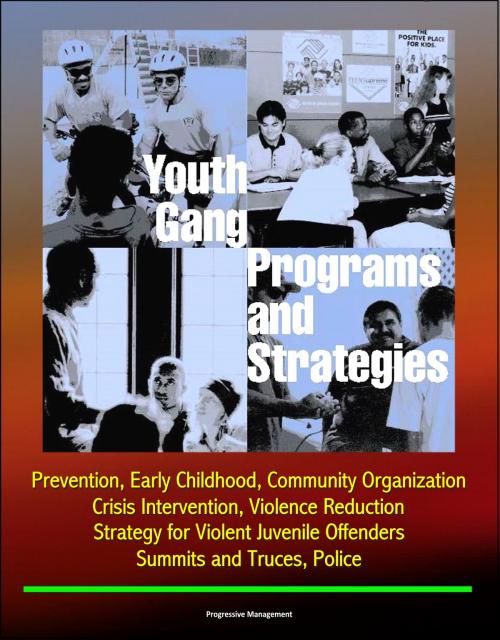Youth Gang Programs and Strategies: Prevention, Early Childhood, Community Organization, Crisis Intervention, Violence Reduction, Strategy for Violent Juvenile Offenders, Summits and Truces, Police
Nonfiction, Social & Cultural Studies, True Crime| Author: | Progressive Management | ISBN: | 9781310291401 |
| Publisher: | Progressive Management | Publication: | January 27, 2015 |
| Imprint: | Smashwords Edition | Language: | English |
| Author: | Progressive Management |
| ISBN: | 9781310291401 |
| Publisher: | Progressive Management |
| Publication: | January 27, 2015 |
| Imprint: | Smashwords Edition |
| Language: | English |
The growth of youth gang violence and the proliferation of youth gangs into smaller cities and rural areas in recent years have focused public attention on the youth gang problem and made it an increasingly significant social policy issue. The public's concern is understandable, with more than 800,000 gang members active in over 3,000 gangs according to the latest National Youth Gang Survey. The Office of Juvenile Justice and Delinquency Prevention (OJJDP) shares this concern and is addressing it on several fronts, in particular, through OJJDP's National Youth Gang Center. Youth Gang Programs and Strategies draws on more than a half-century of gang program evaluations to summarize what we have learned about: Prevention programs (including early childhood, school-based, and afterschool initiatives); Intervention programs (including those that work to create violence-free zones, establish gang summits and truces, and rehabilitate gang members in juvenile detention and correctional facilities); Suppression programs (including those focused on prosecution, police response, and geomapping and other tracking systems); Strategies using multiple techniques (such as community policing); Multiagency initiatives (including local, State, and Federal efforts); Comprehensive approaches to gang problems (such as the Comprehensive Community-Wide Approach to Gang Prevention, Intervention, and Suppression); Legislation (at the local, State, and Federal levels).
This Summary also describes an OJJDP-sponsored nationwide assessment of youth gang prevention, intervention, and suppression programs; debunks prevalent stereotypes surrounding youth gang members; and provides research-based recommendations for enhancing the effectiveness of youth gang programs and strategies. Youth gangs imperil not only the safety of America's communities but the future of our Nation's youth.
Foreword * Acknowledgments * Introduction * Programs and Strategies * Prevention Programs * Community Organization * Improving Conditions and Creating Opportunities * Early Childhood Programs School-Based Programs * Afterschool Activities * Implications of Risk and Protective Factors * Intervention Programs * Detached Worker Programs * Crisis Intervention * Boys & Girls Clubs * Improving Conditions * Violence-Free Zones * Gang Summits and Truces * Emergency Room Intervention and Victim Programs * Gang Members in Juvenile Detention and Correctional Facilities * Suppression Programs * Prosecution Programs * Police Response * Geomapping and Tracking Systems * Strategies Using Multiple Techniques * Community Policing * Community-University Model for Gang Intervention and Delinquency Prevention in Small Cities * Aurora Gang Task Force * Partnership for a Safer Cleveland * SARA * Multiagency Initiatives * Los Angeles Metropolitan Task Force * Boston Gun Project * Bureau of Justice Assistance Gang Suppression Prototype * Minnesota Statewide Task Force * Federal Initiatives * TARGET * Comprehensive Approaches to Gang Problems * The Comprehensive Community-Wide Approach to Gang Prevention, Intervention, and Suppression * The Gang Violence Reduction Program * Comprehensive Strategy for Serious, Violent, and Chronic Juvenile Offenders * Legislation * Federal and State Legislation * City Ordinances and Court Injunctions * Assessment of Youth Gang Programs * Stereotypes Versus Modern Youth Gangs * Recommendations * Conclusion * Footnotes * References * Directory of Programs, Strategies, and Organizations * Index of Programs, Strategies, and Organizations
The growth of youth gang violence and the proliferation of youth gangs into smaller cities and rural areas in recent years have focused public attention on the youth gang problem and made it an increasingly significant social policy issue. The public's concern is understandable, with more than 800,000 gang members active in over 3,000 gangs according to the latest National Youth Gang Survey. The Office of Juvenile Justice and Delinquency Prevention (OJJDP) shares this concern and is addressing it on several fronts, in particular, through OJJDP's National Youth Gang Center. Youth Gang Programs and Strategies draws on more than a half-century of gang program evaluations to summarize what we have learned about: Prevention programs (including early childhood, school-based, and afterschool initiatives); Intervention programs (including those that work to create violence-free zones, establish gang summits and truces, and rehabilitate gang members in juvenile detention and correctional facilities); Suppression programs (including those focused on prosecution, police response, and geomapping and other tracking systems); Strategies using multiple techniques (such as community policing); Multiagency initiatives (including local, State, and Federal efforts); Comprehensive approaches to gang problems (such as the Comprehensive Community-Wide Approach to Gang Prevention, Intervention, and Suppression); Legislation (at the local, State, and Federal levels).
This Summary also describes an OJJDP-sponsored nationwide assessment of youth gang prevention, intervention, and suppression programs; debunks prevalent stereotypes surrounding youth gang members; and provides research-based recommendations for enhancing the effectiveness of youth gang programs and strategies. Youth gangs imperil not only the safety of America's communities but the future of our Nation's youth.
Foreword * Acknowledgments * Introduction * Programs and Strategies * Prevention Programs * Community Organization * Improving Conditions and Creating Opportunities * Early Childhood Programs School-Based Programs * Afterschool Activities * Implications of Risk and Protective Factors * Intervention Programs * Detached Worker Programs * Crisis Intervention * Boys & Girls Clubs * Improving Conditions * Violence-Free Zones * Gang Summits and Truces * Emergency Room Intervention and Victim Programs * Gang Members in Juvenile Detention and Correctional Facilities * Suppression Programs * Prosecution Programs * Police Response * Geomapping and Tracking Systems * Strategies Using Multiple Techniques * Community Policing * Community-University Model for Gang Intervention and Delinquency Prevention in Small Cities * Aurora Gang Task Force * Partnership for a Safer Cleveland * SARA * Multiagency Initiatives * Los Angeles Metropolitan Task Force * Boston Gun Project * Bureau of Justice Assistance Gang Suppression Prototype * Minnesota Statewide Task Force * Federal Initiatives * TARGET * Comprehensive Approaches to Gang Problems * The Comprehensive Community-Wide Approach to Gang Prevention, Intervention, and Suppression * The Gang Violence Reduction Program * Comprehensive Strategy for Serious, Violent, and Chronic Juvenile Offenders * Legislation * Federal and State Legislation * City Ordinances and Court Injunctions * Assessment of Youth Gang Programs * Stereotypes Versus Modern Youth Gangs * Recommendations * Conclusion * Footnotes * References * Directory of Programs, Strategies, and Organizations * Index of Programs, Strategies, and Organizations















